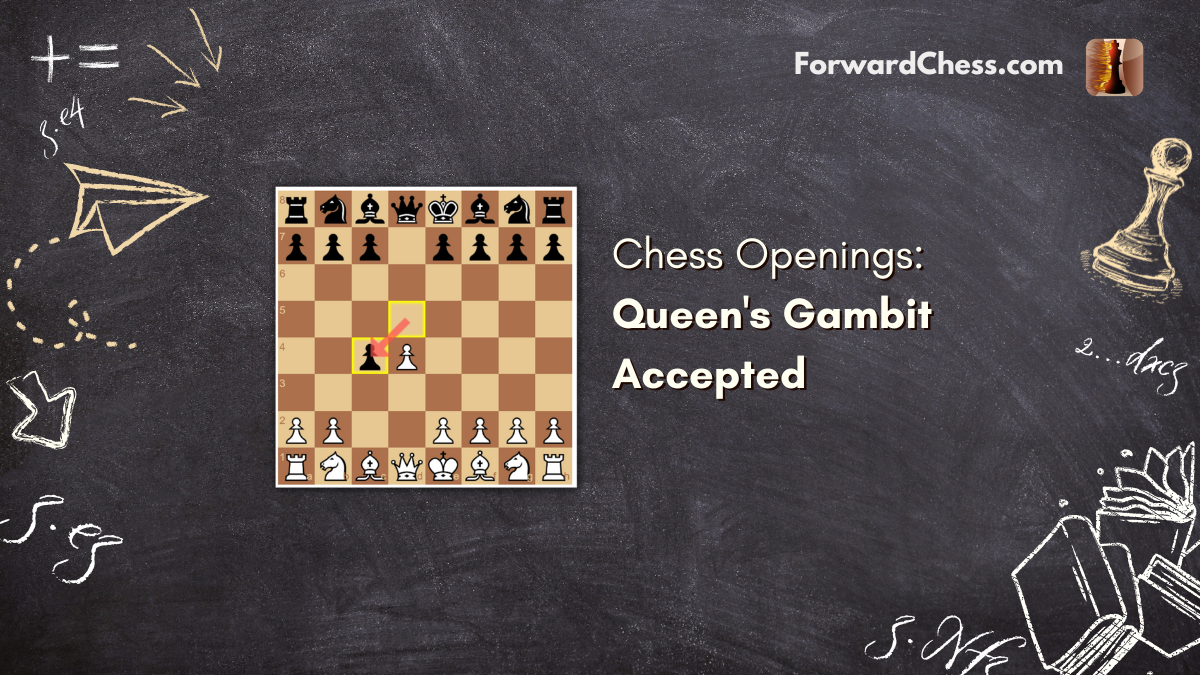The Queen’s Gambit Accepted is one of Black’s main responses to White’s Queens Gambit opening, characterized by the moves 1.d4 d5 2.c4. Let’s take a look at what the Queen’s Gambit is, its origins, and what the Queen’s Gambit Accepted variation entails.
Table of Contents
The Queen’s Gambit
The Queen’s Gambit opening chess is a chess opening, popularized way before the hit Netflix “Queen’s Gambit” series, where White offers a “sacrifice” of the c4-pawn in exchange for control of the center.
The move order goes: 1.d4 d5 2.c4
Here, Black has two ways to respond;
- Accept the Gambit with 2…dxc4
- Decline the Gambit, with a variety of options such as:
- Defending the pawn with 2…e6 (We call this the Queen’s Gambit Declined)
- Defending the pawn with 2…c6 (This is called the Slav Defense)
- Gambit a pawn as well with 2…e5 (This crazy line is called the Albin CounterGambit)
There are of course many other lines and transpositions that occur after declining the gambit, these are just a few.
Queen’s Gambit: Name Origins
“Gambit” in chess lingo is given to openings that include a sacrifice in exchange for some other kind of advantage, such as initiative. Gambit openings include the sacrifice of a pawn, such is the case with the Queen’s Gambit. The first move to be played is usually 1.d4, the Queen’s Pawn, and the c4-pawn on the Queenside is offered as the gambit, which is where the opening’s name comes from. In contrast, the King’s Gambit starts with 1.e4 and offers the Kingside f-pawn as the gambit.
Queen’s Gambit: History
The opening has a long history and has been a popular choice for amateurs and World Champions alike. Old theory saw Black either decline the gambit or accept it and hold on to the pawn as tightly as possible. The 1886 World Championship Match between Wilhelm Steinitz and Johannes Zukertort shined a spotlight on the Queen’s Gambit as it was played in 9 out of 20 games, each time with Steinitz as Black. Steinitz would both decline and accept the c4-pawn grab, but interestingly, he also introduced the idea of not holding onto the pawn in the QGA but instead allowing White to recapture and be left with an isolated pawn.
Here is an example from their match, which transposes into QGA as Black captures the c4-pawn:
Today we will look at what happens when Black captures the pawn with the Queen’s Gambit Accepted.
The Queen’s Gambit Accepted
As the name suggests, Black accepts White’s gambit by capturing the pawn on c4:
With this capture, Black wins material for the moment, and White gains control of the center. Black aims to exploit White’s central pawns in order to attain a long-term endgame advantage by weakening White’s pawn structure. Black sets the stage for a potential counterattack during the middlegame, particularly targeting the isolated pawn on d4 – as we saw in the Zuketort – Alekhine game.
Queen’s Gambit Accepted: Main lines
After 2…dxc4, White has quite a few options and there are a lot of chess books devoted to this repertoire. Let’s take a look at some of White’s 3rd moves:
3.Nf3
The most popular move here. White delays their play to recapture the pawn, and prevents …e5, therefore exerting more control in the center. Black’s most popular response is 3…Nf6 which White most popularly follows with 4.e3, attacking the c4-pawn. Here follows 4…e6 (activating the dark-squared bishop and preparing …c5) 5.Bxc4 c5 6.0-0 a6 known as the Classical Variation.
3.e4
White reinforces control in the center and opens up the bishop to capture on c4. A typical idea for both sides to know is what happens when Black aims to defend the pawn with …b5. Here White can attempt to break up Black’s queenside pawns with a4 and Nc3:
3.e3
Once again, White prepares to recapture on c4, but builds a healthy pawn chain at the same time. Black usually continues with 3…Nf6, but other exciting options such as 3…e5 are also possible.
Queen’s Gambit Accepted: Books to Learn From

1.d4 The Queen’s Gambit: Volume 1B
Author: Boris Avrukh
Publisher: Quality Chess
Level: Advanced
The Queen’s Gambit Accepted
Author: Max Dlugy
Publisher: Russell Enterprises
Level: Advanced


Understanding the Queen’s Gambit Accepted
Author: Alexander Delchev and Semko Semkov
Publisher: Chess Stars
Level: Intermediate
Queen’s Gambit Accepted: Game Examples
Fischer – Spassky 1992
Kasparov – Gulko
The Queen’s Gambit Accepted has been played by numerous chess grandmasters and has a rich history in tournament and World Championship play. It offers both attacking and defensive chances for both sides, with complex strategical and tactical battles that require precise calculation and understanding of pawn structures.
Overall, it is a fascinating opening choice that can lead to exciting and challenging games for both players.
- Rock Solid Chess: Volume 2 - February 21, 2024
- Unsung Heroes of Chess - February 19, 2024
- Build Up Your Chess: The Fundamentals - February 7, 2024
